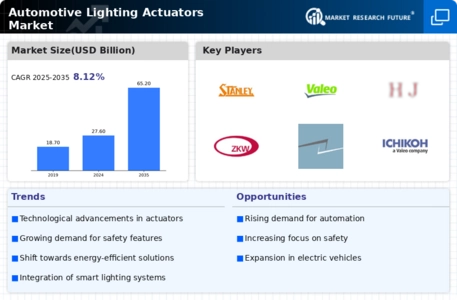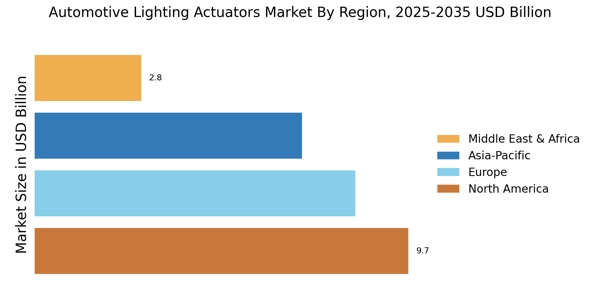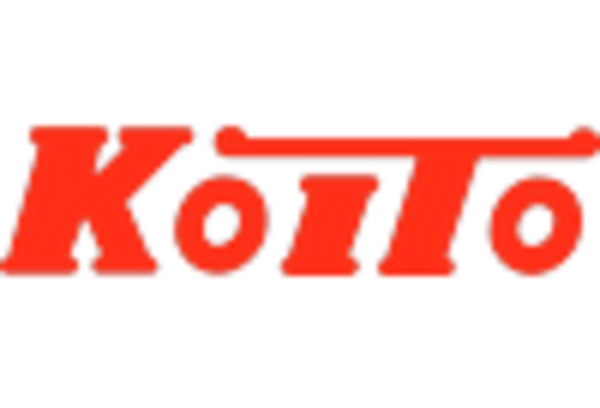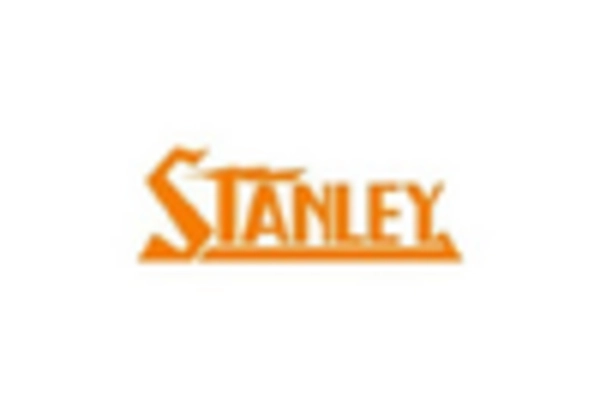Regulatory Standards and Compliance
Regulatory standards and compliance requirements are shaping the Automotive Lighting Actuators Market. Governments across various regions are implementing stringent regulations regarding vehicle safety and environmental impact, which necessitate the adoption of advanced lighting technologies. These regulations often mandate the use of specific lighting systems that enhance visibility and reduce energy consumption. As a result, automotive manufacturers are compelled to invest in high-quality lighting actuators that meet these standards. The market is likely to see a shift towards more innovative solutions that comply with these regulations, thereby driving growth in the actuator segment. This trend indicates a proactive approach by manufacturers to align with evolving regulatory landscapes.
Increasing Vehicle Production and Sales
The Automotive Lighting Actuators Market is poised for growth due to the increasing production and sales of vehicles worldwide. As automotive manufacturers ramp up production to meet consumer demand, the need for efficient and reliable lighting systems becomes paramount. Recent statistics indicate that global vehicle production is expected to exceed 100 million units annually by 2026, which will likely drive the demand for automotive lighting actuators. This increase in vehicle output is accompanied by a rising trend towards customization, where consumers seek unique lighting features, further propelling the market. Consequently, actuator manufacturers are positioned to benefit from this upward trajectory in vehicle production.
Rising Demand for Advanced Safety Features
The Automotive Lighting Actuators Market is experiencing a notable surge in demand for advanced safety features in vehicles. As consumers increasingly prioritize safety, manufacturers are integrating sophisticated lighting systems that enhance visibility and reduce accident risks. This trend is reflected in the growing adoption of adaptive lighting technologies, which adjust beam patterns based on driving conditions. According to recent data, the market for automotive safety systems is projected to grow at a compound annual growth rate of approximately 8% over the next five years. This growth is likely to drive the demand for automotive lighting actuators, as they play a crucial role in the functionality of these advanced systems.
Technological Advancements in Lighting Systems
Technological advancements are significantly influencing the Automotive Lighting Actuators Market. Innovations such as LED and laser lighting technologies are becoming increasingly prevalent, offering improved energy efficiency and longer lifespans compared to traditional lighting solutions. The shift towards these advanced technologies is expected to propel the market, as they provide enhanced illumination and design flexibility. Furthermore, the integration of smart lighting systems, which can adapt to environmental conditions, is likely to create new opportunities for actuator manufacturers. Market data suggests that the LED automotive lighting segment alone is anticipated to reach a valuation of over 30 billion by 2026, indicating a robust growth trajectory for the automotive lighting actuators sector.
Growing Interest in Customization and Aesthetics
The Automotive Lighting Actuators Market is witnessing a growing interest in vehicle customization and aesthetics. Consumers are increasingly seeking personalized lighting solutions that reflect their individual style and enhance the overall appearance of their vehicles. This trend is particularly evident in the aftermarket segment, where custom lighting options are gaining popularity. As a result, manufacturers are focusing on developing versatile lighting actuators that can accommodate various design preferences and functionalities. Market analysis suggests that the aftermarket for automotive lighting is expected to grow significantly, potentially reaching a valuation of over 10 billion by 2025. This shift towards customization is likely to create new opportunities for actuator manufacturers, as they adapt to changing consumer preferences.


















Leave a Comment